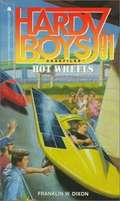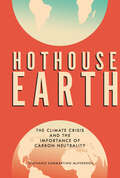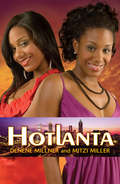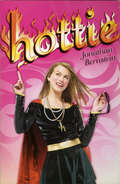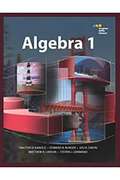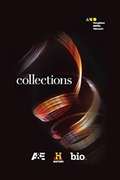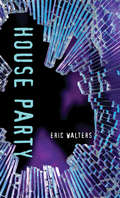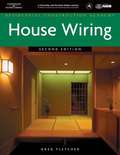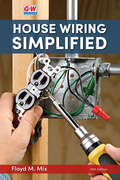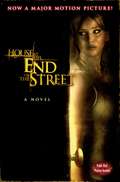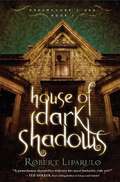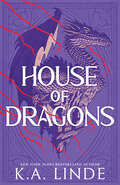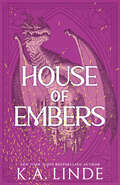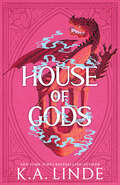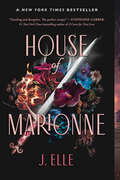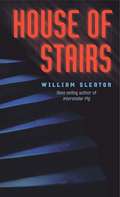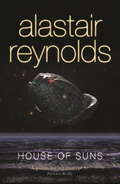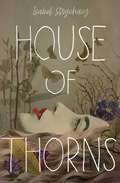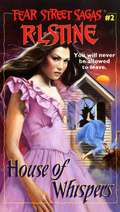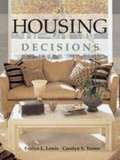- Table View
- List View
Hot Wheels (Hardy Boys Casefiles #91)
by Franklin W. DixonFrom the back of the book: Race to danger! It's ninety degrees in the shade, and temperatures and tempers are boiling over. The Hardys are competing in the Suntex Solar Challenge, a race of super-charged, solar-powered cars across the Arizona desert. But for Frank and Joe, the 500-mile concrete speedway is about to turn into a crash course in sabotage! Not only is a $100,000 prize at stake, but so is the inside track on a multimillion-dollar contract for future car design. And someone's determined to win at any cost. Facing flash fires, stun grenades, and deadly electric shocks, the Hardys put the pedal to the metal in their scorching-hot chase after a high-speed, high-tech terrorist!
Hothouse Earth: The Climate Crisis and the Importance of Carbon Neutrality
by Stephanie Sammartino McPhersonAs hurricanes, droughts, floods, and wildfires are increasing in regularity and intensity, climate change can no longer be ignored. Melting permafrost, forest dieback, ocean acidification, and other processes are creating positive feedback loops which could, if not aggressively and quickly addressed, spiral out of control and take global warming past the point of no return. Hothouse Earth examines how science, politics, and social justice must all be part of the equation to counteract climate change.
Hotlanta: Book 1 (Hotlanta #1)
by Mitzi Miller Denene MillnerDesigner clothes. Gorgeous boys. Family secrets. Major drama. Welcome to Atlanta and the lives of the Duke twins, Sydney and Lauren. They don't call it Hotlanta for nothing!The Duke twins, Sydney and Lauren, live the life: They attend the fanciest school in Atlanta, they live in Buckhead, the most exclusive neighborhood, and they only date the hottest guys. And their secrets? Are the darkest of all. When their estranged father is released from prison and a murder is committed, their lives are plunged into a whirlwind of tabloid scrutiny, vicious gossip, and shocking revelation. Lauren, always such a party girl, and Sydney, bent on perfection by way of the Ivy League, can't trust anyone. Not their mother, not their rich stepfather. Maybe not even each other.
Hottie
by Jonathan BernsteinAlison Cole's got it all: She's gorgeous, dating a steamy surfer boy, and has just been crowned Beverly Hills High Freshman Class President. Then during a special "symmetry" surgery, a lightning bolt zaps her, and Alison instantly transforms into Hottie - that is, a totally sizzling superhero with the power to shoot fire from her fingers!<P> Shunned as a Pyro-Freak, Alison must adopt dorky David Eels as her crime-fighting sidekick. Worse, she's falling for the one guy who wants to "extinguish" her forever, Junior Class President of Cuteness - and wannabe firefighter - T. Hull. But she doesn't realize that a supervillain's lurking....<P> Has Hottie met her match?
Houghton Mifflin English [Grade 11]
by Shane Templeton Robert Rueda Tina Saldivar Lynne Shapiro C. Ann Terry Catherine Valentino Shelby A. WolfNIMAC-sourced textbook
Houghton Mifflin Harcourt Algebra 1
by Timothy D. Kanold Edward B. Burger Juli K. Dixon Steven J. Leinwand Matthew R. LarsonHMH Algebra 1 is built on the 5E instructional model-Engage, Explore, Explain, Elaborate, Evaluate-to develop strong conceptual understanding and mastery of key mathematics standards.
House Made of Dawn (The\momaday Collection)
by N. Scott MomadayThe magnificent Pulitzer Prize-winning novel of a stranger in his native land A young Native American, Abel has come home from a foreign war to find himself caught between two worlds. The first is the world of his father's, wedding him to the rhythm of the seasons, the harsh beauty of the land, and the ancient rites and traditions of his people. But the other world -- modern, industrial America -- pulls at Abel, demanding his loyalty, claiming his soul, goading him into a destructive, compulsive cycle of dissipation and disgust. And the young man, torn in two, descends into hell.
House Party (Orca Soundings)
by Eric WaltersAs the new girl in a strange town, Casey is trying desperately to fit in and make friends. When her parents leave town for the weekend, her friend suggests she have a house party. Casey is reluctant to go along, until she realizes maybe this is the answer to fitting in and making friends—and getting back at her parents. They invite a few people and then a few more, using msn and text messaging. Hundreds of people show up and things get out of hand. Casey is in more trouble than she thought possible and now she must decide whether—and how—to do the right thing. This short novel is a high-interest, low-reading level book for teen readers who are building reading skills, want a quick read or say they don’t like to read! The epub edition of this title is fully accessible.
House Wiring
by Greg FletcherWith the same innovative "hands-on" approach and task-focused organization that made the first edition so popular, Residential Construction Academy: House Wiring, 2E has been updated to reflect the most current electrical wiring practices in use, including the 2008 National Electrical Code. Designed to highlight the principles and practices used in the installation of a residential electrical wiring system, as well as how to effectively put them into practice, this book provides a valuable resource for lear
House Wiring Simplified
by Floyd M. MixHouse Wiring Simplified presents fundamental, safe installation information and procedures, enhanced by the inclusion of easy-to-understand drawings. This short text is the perfect resource for a residential electricity module included in comprehensive construction programs. Content covers wiring in both older and newer homes. This text also includes details on how to determine what wiring is needed and what equipment and materials to use. Color-coded diagrams aid in the explanation of various types of circuits.
House at the End of the Street
by Lily Blake David Loucka Jonathan MostowSeeking a fresh start, newly divorced Sarah and her daughter Elissa find the house of their dreams in a small, upscale, rural town. But when startling and unexplainable events begin to happen, Sarah and Elissa learn the town is in the shadows of a chilling secret. Years earlier, in the house next door, a daughter killed her parents in their beds, and disappeared - leaving only a brother, Ryan, as the sole survivor. Against Sarah's wishes, Elissa begins a relationship with the reclusive Ryan - and the closer they get, the deeper they're all pulled into a mystery more dangerous than they ever imagined.
House of Curses (Royal Houses #3)
by K.A. LindeNew York Times bestselling author K.A. Linde returns to the Royal Houses series with House of Curses: the story of Kerrigan Argon, a half-Fae, half-human as she seeks her place in an unforgiving world filled with magic, mayhem, and romance. A YA romantasy perfect for fans of Sarah J. Maas, Holly Black, and V.E. Schwab.Magic. Power. Legacy. She was never meant to have any of them. Now she might control them all.Kerrigan Argon was born half-human, half-Fae—fully rejected by both. But when she shatters expectations to become a dragon rider, the world that once scorned her can no longer ignore her rise.Only now, everything she's gained is at risk.Her prince has vanished into shadow. A forced political marriage looms. And in a shocking twist, she's been nominated to lead the very council that once sought to keep her out.Worse, a violent faction known as the Red Masks is gaining ground—fueled by an insider's betrayal. War brews, and Kerrigan is caught between the old ways that tried to crush her and the dangerous hope of what could rise in their place.Tropes to love:Outcast heroineCursed prince heroMagical societyDragon academyEnemies to loversSlow burnPraise for Royal Houses:"An epic foray into a world of power and mystery that caught me from the first page. Fans of Leigh Bardugo and Stephanie Garber will love this thrilling and romantic start to a brand new series." — Carrie Ann Ryan, New York Times bestselling author"HOW DID I NOT KNOW THIS BOOK WAS THE MISSING PART OF MY SOUL? If you are a Sarah J Maas fan, this is for you. If you are a fantasy fan, this is for you. If you aren't a fantasy fan, this book is also likely for you." — Novel Grounds"Absolutely hooked from page one! Love the feisty and strong heroine! Fully obsessed with the dragons, magic, and a dark hero who might be more than what he seems. K.A. Linde has become my go-to author. Sarah J. Maas fans will love this book!" — Sawyer Bennett, New York Times bestselling author"6 stars! Even better than A Court of Thorns and Roses! A masterfully crafted enchanting flight of adventure, friendship, loss, and love." — Lauren Campbell, USA Today bestselling author
House of Dark Shadows (Dreamhouse Kings #1)
by Robert LiparuloDream house . . . or bad dream? When the Kings move from L. A. to a secluded small town, fifteen-year-old Xander is beyond disappointed. He and his friends loved to create amateur films . . . but the tiny town of Pinedale is the last place a movie buff and future filmmaker wants to land. But he, David, and Toria are captivated by the many rooms in the old Victorian fixer-upper they moved into--as well as the heavy woods surrounding the house. They soon discover there's something odd about the house. Sounds come from the wrong directions. Prints of giant, bare feet appear in the dust. And when David tries to hide in the linen closet, he winds up in locker 119 at his new school. Then the really weird stuff kicks in: they find a hidden hallway with portals leading off to far-off places--in long-ago times. Xander is starting to wonder if this kind of travel is a teen's dream come true . . . or his worst nightmare.
House of Dragons (Royal Houses #1)
by K.A. LindeNew York Times bestselling author K.A. Linde introduces the Royal Houses series with House of Dragons: the story of Kerrigan Argon, a half-Fae, half-human, as she seeks her place in an unforgiving world filled with magic, mayhem, and romance. A YA romantasy perfect for fans of Sarah J. Maas, Holly Black, and V.E. Schwab.She's the half-Fae outcast. He's the cursed prince. Their choices could reshape the realm.Ten years ago, half-Fae, half human Kerrigan Argon was discreetly dropped off onto the steps of Draco Mountain with nothing but a note. Her life changes completely as she's swept into the care of the House of Dragons—an elite training program for gifted Fae.On the year of her seventeenth name day, each student will be chosen by one of the twelve houses of Alandria to enter society.Everyone is chosen…except Kerrigan.So, she strikes a bargain with the Dragon Society: convince a house to select her or give up her birthright forever. With the unlikeliest of allies—Fordham Ollivier, the cursed Fae prince, who escaped his dark throne—she must chart her own destiny to reshape the world.Tropes to love:Outcast heroineCursed prince heroMagical societyDragon academySecret identityEnemies to loversSlow burnPraise for Royal Houses:"An epic foray into a world of power and mystery that caught me from the first page. Fans of Leigh Bardugo and Stephanie Garber will love this thrilling and romantic start to a brand new series." — Carrie Ann Ryan, New York Times bestselling author"HOW DID I NOT KNOW THIS BOOK WAS THE MISSING PART OF MY SOUL? If you are a Sarah J Maas fan, this is for you. If you are a fantasy fan, this is for you. If you aren't a fantasy fan, this book is also likely for you." — Novel Grounds"Absolutely hooked from page one! Love the feisty and strong heroine! Fully obsessed with the dragons, magic, and a dark hero who might be more than what he seems. K.A. Linde has become my go-to author. Sarah J. Maas fans will love this book!" — Sawyer Bennett, New York Times bestselling author"6 stars! Even better than A Court of Thorns and Roses! A masterfully crafted enchanting flight of adventure, friendship, loss, and love." — Lauren Campbell, USA Today bestselling author
House of Embers (Royal Houses #5)
by K.A. LindeNew York Times bestselling author K.A. Linde returns with House of Embers, the finale to the Royal Houses series, a delicious YA romantasy that Booktok called "Fourth Wing meets Throne of Glass."A god's legacy. A lover's bond. A world on the brink.Kerrigan Argon never asked to be a hero. But after falling from the land of the gods with only her mate and her mother's bangle, destiny refuses to let her go.Half-Fae and humans are disappearing. The Red Masks now rule the Dragon Society, enforcing a reign of terror built on ancient lies Kerrigan has uncovered—and can no longer ignore.As darkness tightens its grip, Kerrigan must risk everything: her power, her heart, and the fragile future she and her mate barely had a chance to claim.Because the only way to save their world is to set it ablaze.Tropes to love:Outcast heroineCursed prince heroMagical societyDragon academyEnemies to loversSlow burnFated matesPraise for Royal Houses:"An epic foray into a world of power and mystery that caught me from the first page. Fans of Leigh Bardugo and Stephanie Garber will love this thrilling and romantic start to a brand new series." — Carrie Ann Ryan, New York Times bestselling author"HOW DID I NOT KNOW THIS BOOK WAS THE MISSING PART OF MY SOUL? If you are a Sarah J Maas fan, this is for you. If you are a fantasy fan, this is for you. If you aren't a fantasy fan, this book is also likely for you." — Novel Grounds"Absolutely hooked from page one! Love the feisty and strong heroine! Fully obsessed with the dragons, magic, and a dark hero who might be more than what he seems. K.A. Linde has become my go-to author. Sarah J. Maas fans will love this book!" — Sawyer Bennett, New York Times bestselling author"6 stars! Even better than A Court of Thorns and Roses! A masterfully crafted enchanting flight of adventure, friendship, loss, and love." — Lauren Campbell, USA Today bestselling author
House of Gods (Royal Houses #4)
by K.A. LindeNew York Times bestselling author K.A. Linde returns to the Royal Houses series with House of Gods: the story of Kerrigan Argon, a half-Fae, half-human as she seeks her place in an unforgiving world filled with magic, mayhem, and romance. A YA romantasy perfect for fans of Sarah J. Maas, Holly Black, and V.E. Schwab.Trapped in a realm of gods. Stripped of her magic. Hunted by fate itself. Kerrigan Argon's only way home is to survive the arena.Kerrigan Argon—half-Fae, half-human—has lost everything. Her world. Her powers. The dark prince who held her heart. Now cast into the gods' domain, she finds herself alone, powerless, and forced into a brutal gladiator ring where the price of failure is death.Victory promises a single boon from the gods. And Kerrigan will stop at nothing to win—because beyond the blood-soaked sand lies her only hope to save the people she loves.But this new world is full of deception, divine cruelty, and enemies cloaked as allies. And as trials escalate, so does the cost of survival. Kerrigan must rise—without magic, without certainty, and against all odds.Tropes to love:Outcast heroineCursed prince heroMagical societyDragon academyEnemies to loversSlow burnPraise for Royal Houses:"An epic foray into a world of power and mystery that caught me from the first page. Fans of Leigh Bardugo and Stephanie Garber will love this thrilling and romantic start to a brand new series." — Carrie Ann Ryan, New York Times bestselling author"HOW DID I NOT KNOW THIS BOOK WAS THE MISSING PART OF MY SOUL? If you are a Sarah J Maas fan, this is for you. If you are a fantasy fan, this is for you. If you aren't a fantasy fan, this book is also likely for you." — Novel Grounds"Absolutely hooked from page one! Love the feisty and strong heroine! Fully obsessed with the dragons, magic, and a dark hero who might be more than what he seems. K.A. Linde has become my go-to author. Sarah J. Maas fans will love this book!" — Sawyer Bennett, New York Times bestselling author"6 stars! Even better than A Court of Thorns and Roses! A masterfully crafted enchanting flight of adventure, friendship, loss, and love." — Lauren Campbell, USA Today bestselling author
House of Marionne (House of Marionne #1)
by J. ElleAn INSTANT New York Times bestseller!An INSTANT USA TODAY bestseller!An INSTANT Sunday Times bestseller! A modern-day YA romantic fantasy series opener about a glamorous magical world of social elites, forbidden love, and a dark magic that could destroy it all. "Dazzling and deceptive. The perfect escape!" – Stephanie Garber, #1 New York Times bestselling author of The Ballad of Never After"The forbidden love story of my wildest dreams!" – Ali Hazelwood, New York Times bestselling author of The Love HypothesisBURY YOUR SECRET OR DIE FOR IT.17-year-old Quell has lived her entire life on the run. She and her mother have fled from city to city in order to hide the deadly magic that flows through Quell&’s veins. Until someone discovers her dark secret.To hide from the assassin hunting her and keep her mother out of harm&’s way, Quell reluctantly inducts into a debutante society of magical social elites called the Order that she never knew existed. If she can pass their three rites of membership, mastering their proper form of magic, she&’ll be able to secretly bury her forbidden magic forever. If caught, she will be killed.But becoming the perfect debutante is a lot harder than Quell imagined, especially when there&’s more than tutoring happening with Jordan, her brooding mentor and assassin-in-training. When Quell uncovers the deadly lengths the Order will go to defend its wealth and power, she&’s forced to choose: Embrace the dark magic she&’s been running from her entire life, or risk losing everything, and everyone, she&’s grown to love.Still, she fears the most formidable monster she&’ll have to face is the one inside.Brimming with ballgowns and betrayal, magic and mystery, decadence and darkness, House of Marionne is perfect for readers who crave morally gray characters, irresistible romance, dark academia, and a deeply intoxicating and original world.
House of Rage and Sorrow: Book Two in the Celestial Trilogy (Celestial Trilogy)
by Sangu MandannaOne kingdom. One crown. One family.“Maybe it’s time the great House of Rey came to an end. After all, what are we now? Just a house of rage and sorrow.” Esmae once wanted nothing more than to help her golden brother win the crown of Kali but that dream died with her best friend. Alexi broke her heart, and she vowed to destroy him for it. And with her sentient warship Titania beside her, how can she possibly fail? As gods, beasts, and kingdoms choose sides, Alexi seeks out a weapon more devastating than even Titania. Past lives threaten the present. Old enemies claim their due. And Esmae cannot outrun the ghosts and the questions that haunt her. What really happened to her father? What was the third boon her mother asked of Amba? For in the shadows, lurking in wait, are secrets that will swallow her whole. The House of Rey is at war. And the entire galaxy will bleed before the end.
House of Shadows (Royal Houses #2)
by K.A. LindeNew York Times bestselling author K.A. Linde returns to the Royal Houses series with House of Shadows: the story of Kerrigan Argon, a half-Fae, half-human as she seeks her place in an unforgiving world filled with magic, mayhem, and romance. A YA romtantasy perfect for fans of Sarah J. Maas, Holly Black, and V.E. Schwab.A half-Fae outcast. A forbidden prince. A world teetering on the edge of collapse.Kerrigan Argon was never meant to be chosen. As a half-human, half-Fae pariah, her admission into the Dragon Society breaks every law of her world. Now she's bound to a dragon—and to a brutal year of training that could claim her life.But first, she must survive a journey into the infamous House of Shadows, led by the dark Fae prince Fordham Ollivier. No half-Fae has ever returned from its halls. In a place built on cruelty, secrets, and absolute power, Kerrigan must battle not just enemies—but centuries of prejudice and the slow unraveling of magic itself.Something ancient is cracking. A long-buried spell is weakening. And Kerrigan may be the only one who can stop the collapse—or cause it.Tropes to love:Outcast heroineCursed prince heroMagical societyDragon academyEnemies to loversSlow burnPraise for Royal Houses:"An epic foray into a world of power and mystery that caught me from the first page. Fans of Leigh Bardugo and Stephanie Garber will love this thrilling and romantic start to a brand new series." — Carrie Ann Ryan, New York Times bestselling author"HOW DID I NOT KNOW THIS BOOK WAS THE MISSING PART OF MY SOUL? If you are a Sarah J Maas fan, this is for you. If you are a fantasy fan, this is for you. If you aren't a fantasy fan, this book is also likely for you." — Novel Grounds"Absolutely hooked from page one! Love the feisty and strong heroine! Fully obsessed with the dragons, magic, and a dark hero who might be more than what he seems. K.A. Linde has become my go-to author. Sarah J. Maas fans will love this book!" — Sawyer Bennett, New York Times bestselling author"6 stars! Even better than A Court of Thorns and Roses! A masterfully crafted enchanting flight of adventure, friendship, loss, and love." — Lauren Campbell, USA Today bestselling author
House of Stairs
by William SleatorFive 16 year old orphans are involuntarily placed in a house of endless stairs as subjects for a psycological experiment on conditioned human response.
House of Suns
by Alastair ReynoldsA spectacular, large-scale space opera - the ultimate galaxy-spanning adventureSix million years ago, at the very dawn of the starfaring era, Abigail Gentian fractured herself into a thousand male and female clones: the shatterlings. Sent out into the galaxy, these shatterlings have stood aloof as they document the rise and fall of countless human empires. They meet every two hundred thousand years, to exchange news and memories of their travels with their siblings.Campion and Purslane are not only late for their thirty-second reunion, but they have brought along an amnesiac golden robot for a guest. But the wayward shatterlings get more than the scolding they expect: they face the discovery that someone has a very serious grudge against the Gentian line, and there is a very real possibility of traitors in their midst. The surviving shatterlings have to dodge exotic weapons while they regroup to try to solve the mystery of who is persecuting them, and why - before their ancient line is wiped out of existence, forever.
House of Thorns
by Isabel StrychaczIn the vein of The Haunting of Hill House, a teen returns to the mysterious house from her past to search for her missing sister and uncover the truth of Brier Hall in this atmospheric and eerie modern gothic novel.Lia Peartree is haunted—by memories, by her past, by secrets, by the ones she left behind. Five years ago, the Peartrees fled their home—the infamous ancestral Brier Hall—and never looked back. But her oldest sister went missing that night, and there&’s been no sign of her since. In the aftermath, the Peartrees are traumatized and get by however they can. Lia&’s remaining sister Ali says yes to any bad idea, and Lia tries so desperately to be the perfect daughter that it&’s tearing her apart. But as the five year anniversary of the night they left nears, Lia begins seeing her missing sister everywhere, and memories of Brier Hall won&’t leave her alone. When Ali disappears with no warning except a cryptic phone call—&“don&’t follow me when I&’m gone&”—Lia is sure she&’s gone back to Brier Hall. Lia must go home one final time and face what haunts her in an effort to find her sisters and uncover the truth of her past.
House of Whispers: A New Fear; House Of Whispers; Forbidden Secrets (Fear Street Saga #2)
by R.L. StineAmy Pierce knows nothing of the terrifying Fear history when she arrives for a visit with Simon and Angelica Fear. Their New Orleans mansion is beautiful—but Amy senses something evil there. Something that watches her. Waits for her. Will Amy be strong enough to escape the powers controlled by the Fear family?
Housing Decisions
by Evelyn L. Lewis Carolyn S. TurnerHousing Decisions is designed to encourage a broad understanding and appreciation of the housing and interior design fields. Topics will lead you through the many issues faced when selecting and personalizing a home. Various housing and design options are presented to help you recognize the wide variety of choices available for addressing different needs and life situations.
